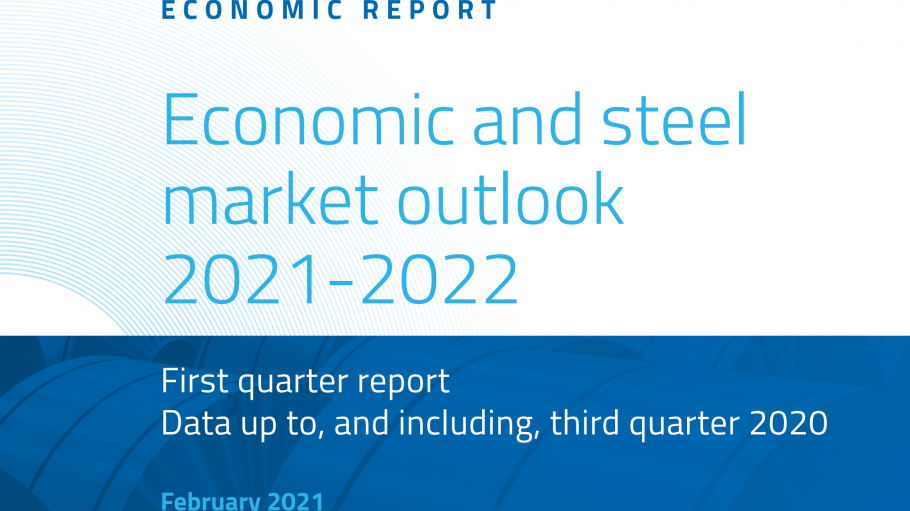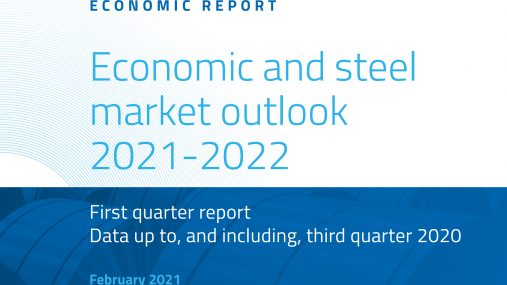
Publications » Economic and market outlook » Economic and steel market outlook 2021-2022, first quarter
Economic and steel market outlook 2021-2022, first quarter
Downloads and links
Recent updates

The COVID-19 pandemic slashed steel consumption forecasts and the overall economic outlook across the EU. Shutdown measures implemented by governments that began in earnest in March 2020 severely impacted manufacturing activity and steel-using industrial sectors. However, some of the measures that had the greatest impact on the economy were loosened as of June 2020, though many measures remain in effect or have been reinforced in recent months.
EU steel market overview
EU28 apparent steel consumption fell (-11.6%) year-on-year in the third quarter of 2020 (that is for the seventh consecutive quarter, after an unprecedented drop (-25%) in the second quarter) and amounted to 32.8 million tonnes.
The volume for the third quarter 2020, albeit higher than the record low seen in the second quarter, reflects the unprecedented deterioration in steel demand due to the severe disruption brought by the Covid-19 pandemic, in addition to the negative factors that had materialised in the preceding quarters and had already led to a sharp, continued reduction in steel consumption.
As a result, the downturn in steel demand led to the eighth consecutive fall year-on-year in domestic deliveries in the EU in the third quarter of 2020 (i.e. -8%, much lower than -28.1% recorded in the second quarter).
Data for the third quarter also showed the continued downturn in imports from third countries. After the severe drop (-16.8%) in the second quarter of 2020, imports from third countries dropped even more severely in the third quarter of 2020, with a year-on-year fall (-25.4%), that is the fourth consecutive quarterly drop of more than 10%.
EU steel-using sectors
The COVID-19 outbreak has further hit EU industrial sectors at a time when these had already been experiencing a severe downturn and were coping with serious challenges. Over the course of 2019, business conditions in the manufacturing industry had continued to deteriorate. This downward trend has gained speed in the second half of 2019, particularly in the automotive industry, while the construction sector has continued to outperform other major steel-using sectors.
This has resulted in a pronounced slowdown in output growth in steel-using sectors. This has culminated in unprecedented drops over the second quarter 2020, mainly as a result of the severe lockdown measures imposed by governments in March and April 2020. Total output in steel-using sectors fell (-24.4%) in the second quarter of 2020. In the third quarter of 2020, output in steel-using sectors has rebounded compared to the previous quarter – thanks to restarted industrial activity across the EU – but has nevertheless fallen year-on-year (-6.4%).

Download this publication or visit associated links
Strasbourg, 17 December 2025 – The European Commission’s latest proposals on the Carbon Border Adjustment Mechanism (CBAM), unveiled today, correctly identify several loopholes that risk undermining its effectiveness, notably regarding EU exports, downstream sectors and circumvention practices. However, despite these laudable efforts, the measures put forward fail to deliver a comprehensive and durable response to carbon and jobs leakage, warns the European Steel Association (EUROFER).
A milestone occasion to quickly and effectively restore affordable electricity, to relaunch the
decarbonization and strengthen the international competitiveness of the European steel
industry.
Brussels, 02 December 2025 – Unchanged negative conditions – U.S. tariffs and trade disruptions, economic and geopolitical tensions, protracted weak demand and still high energy prices – continue to weigh on the European steel market. EUROFER’s latest Economic and Steel Market Outlook confirms for 2025 another recession in both apparent steel consumption (-0.2%, unchanged) and steel-using sectors (-0.5%, revised from -0.7%). A potential recovery is expected only in 2026 for the Steel Weighted Industrial Production index (SWIP) (+1.8%, stable) and for apparent steel consumption (+3%, slightly revised from +3.1%) – although consumption volumes would still remain well below pre-pandemic levels. Steel imports retained historically high shares (27%), while exports plummeted (-9%) in the first eight months of 2025.